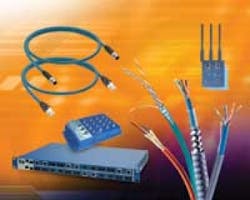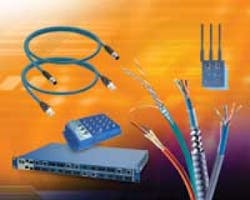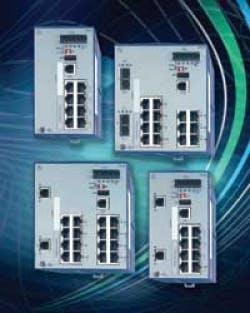Optimizing Ethernet systems in manufacturing plants
Consider environmental risks and select hardened cabling, networking devices to ensure long-term performance and reliability.
Industrial Ethernet is trending to be the principal infrastructure choice for plant-floor networks, just as Ethernet has long been the standard communications protocol in business offices. Both are built on the same standards-based networking platform, the Ethernet local area network (LAN) standard IEEE 802.3. The key advantage of industrial Ethernet is that it allows manufacturers to deploy a single platform to enable interoperability in connecting plant-operations to corporate and administrative offices, and the Internet.
This convergence of open, standards-based Ethernet communications between plant and office levels of an enterprise generates advantages for both, including the following.
- Ubiquitous access to real-time data to improve plant operations
- Real-time collaboration, inventory visibility, and production planning
- Shop-floor system integration with enterprise resource planning (ERP) for scheduling, planning, quality tracking, and delivery information
- Reduced total cost of ownership (TCO) due to faster installation as well as less-costly maintenance and upgrades
Different environments, different approaches
There is a huge difference between installing Ethernet in an office environment where cables, hardware, and connectivity components are sheltered and protected, and installing them on the manufacturing floor. In industrial sites, network components may be exposed to temperature extremes, ultraviolet radiation (sunlight), moisture, oil, chemicals, and other contaminants—all of which can degrade the components’ physical integrity and electrical performance, resulting in intermittent outages or even total system shutdown.
Normal plant activities may also pose risk to network components. For example, there may be constant machine movement and vibration, robotic machinery generating spikes that increase electromagnetic interference or radio frequency interference (EMI/RFI), forklifts, and other mechanized vehicles traversing the work floor. These can damage sensitive electronics, and even the best commercial off-the-shelf (COTS) Ethernet systems are not made to withstand such harsh and hazardous conditions.
The following guidelines are offered to help manufacturers ensure that the plant-floor communications infrastructure is built tough enough to withstand these challenges.
Consider downtime’s real cost
Manufacturers rely on automation, instrumentation, and control data communications to relay signals between machinery, devices, and control systems that activate events on an exacting and predetermined schedule, with little or no margin for error.
Network administrators also require optimal security and manageability so that network availability attains 99.999 percent uptime or better. Yet analysts report that a large percentage of unplanned downtime in industrial operations is caused by network infrastructure problems. According to one such report, fully 72 percent of network faults can be attributed to failure at the Open Systems Interconnection (OSI) Layer 1 (physical media), Layer 2 (data link), and/or Layer 3 (network).
Physical deterioration or electrical failure in critical data transmission components can lead to unreliable network performance and safety issues, and may lead to loss of critical data, system downtime, or even catastrophic failure. No matter what the industry, if a switch, connector, or cabling system fails, the cost of parts replacement and repair represents only a tiny fraction of the overall costs associated with production downtime.
The indirect costs of Ethernet system failure may include lost productivity, delayed processes, cost of system shutdown and startup, possible lapses in security and safety, and the loss of service to customers relying on the plant’s output. These can send total downtime costs soaring to hundreds of thousands, or even millions of dollars. For example, an automotive assembly plant capable of producing one vehicle per minute would stand to lose profits of about $2,000 to $3,000 per minute for small-car production, and up to $8,000 per minute for SUV and pickup-truck production.
Specify industrial-grade components
In specifying Ethernet physical media, data links, and network hardware for plant-floor installation, it is important to select hardened, industrial-grade components offering rugged construction and durability to provide optimal performance over long service life. High-quality industrial-grade Ethernet products should provide a lifespan similar to that of other automation-system components—typically 10 to 30 years, which is significantly more than COTS products can deliver.
Other factors to consider include the following.
- Conformity with the Ethernet IEEE 802.3 standard
- Mean time between failure analysis
- Mounting options such as DIN rail mounted, rack- or panel-mounted, or devices that bolt securely onto machines
- A small form factor to occupy less space and allow greater density within the limited space of control panels
Cable and connectivity options
For the physical media layer, there are a host of industrial-grade products that conform to the Ethernet IEEE 802.3 standard, while resisting the effects of sunlight, volatile temperatures, moisture, and chemicals. Industrial cables will operate effectively in a wider temperature range (-40 deg. C to +85 deg. C) than commercial cables (0 deg. C to +60 deg. C). Selection will depend on each plant’s network configuration and application requirements.
Industrial Ethernet cables and connectivity options include the following.
- Heavy-duty, all-dielectric, indoor/outdoor-rated optical-fiber cabling in singlemode and multimode constructions. Many feature water-blocking agents for added protection in moisture-laden environments.
- Industrial-grade Category 5e and Category 6 cables with heavy-duty oil- and UV-resistant jackets. Some Category cables feature a bonded-pair inner construction in which the conductor insulation of the pairs is affixed along their longitudinal axis to ensure consistent conductor concentricity and prevent performance-robbing gaps between the conductor pairs during installation and use.
- Upjacketed and armored cables for extreme environments.
- Continuous-flex cables designed for use with continuous-motion machines and automation systems.
- Low-smoke/zero-halogen (LSZH) cables, waterblocked, and burial cables.
- Cables designed for use with leading industrial automation networking and communications protocols, such as EtherNet/IP (ODVA), Modbus TCP/IP, ProfiNet, and Fieldbus HSE.
- Industrial-grade connectivity components, such as IP67- or IP20-rated UTP or STP patch cords, connectors, modular jack-and-plug kits, adapters, faceplates, and surface-mount boxes.
- Industrial-grade Category 5e RJ-45 and Micro (M12) cordsets and patch cords, including high-flex versions.
Switches and hardware options
Similarly, at the information, control, and device layers, a wide range of options is available. There are products to support both copper and optical-fiber media, and switches capable of data speeds as high as 10 Gbits/sec. At a minimum, all of these components—switches, connectors, and other hardware—should offer robust construction and resistance to high temperatures, vibration, and EMI.
Typical COTS hardware is designed to operate from 0 deg. C to +40 deg. C, while industrial-grade Ethernet hardware operates efficiently from 0 deg. C to +60 deg. C—extendable to -40 deg. C to +85 deg. C. Also, excessive moisture and corrosive chemicals can inflict serious damage to the electronics in commercial switches, whereas ruggedized industrial switches can be securely sealed to prevent ingress of these substances. Conformal coating is also available for humid/moist applications.
Belden offers a full line of Hirschmann networking devices to ensure hassle-free and secure data communications, even under tough environmental conditions.
Here is a list of hardware components for Industrial Ethernet networks.
- Hardened managed and unmanaged switches, which come in a variety of copper/fiber port configurations, port densities, industry approvals, and mounting options.
- Firewalls to secure and isolate a network while still permitting authorized data communications to pass through. Firewalls with virtual private network capabilities also allow secure, encrypted communications from a remote location through the Internet.
- Wireless access points, clients, and bridges in either DIN rail mount or IP67 enclosure-less housings now also support the faster, more secure, and noise-immune 802.11n standard.
- Related accessories, such as hardened power supplies, small-form-pluggable fiber transceivers, and even software that provides network status, alerts, and control from the automation network’s software or programmable logic controller.
Plan ahead for bandwidth and redundancy
With an ever-increasing number of Ethernet-cabled devices being added in today’s automation and control networks, it is an industry best practice to allow for sufficient bandwidth to handle current needs, with additional headroom to accommodate future expansion. This is far less costly and labor-intensive than having to upgrade incrementally over time.
One factor often overlooked when it comes to maximizing network uptime and performance is redundancy, which is also considered an industry best practice, especially in mission-critical applications. Two kinds of redundancy are key to maintaining uninterrupted signal transmission and maximum uptime.
The first is power source redundancy. Specifying switches that have dual power input capabilities means that if one power source fails, the other immediately takes over.
The second is data path redundancy. The daisy-chain network topologies used by many industrial plants to connect automated machinery and devices have one inherent flaw: if any link between two switches fails, the entire system could potentially go down, as the devices on one network segment can no longer communicate with devices in other segments. The solution is to ensure a built-in redundant path into the network topology.
Another trend gaining traction across the industrial sector is specifying network infrastructure components from a supplier capable of providing end-to-end, field-proven Ethernet solutions tailored specifically to end-user applications and environments. As many companies have discovered, taking a “total system” approach can be more cost-effective over the long run in terms of easing maintenance, troubleshooting, and upgrades. And an integrated system typically results in greater reliability in delivering optimal performance, as well as increased peace of mind for those responsible for optimizing network performance day in and day out.
Bill Wotruba is director of networking and connectivity products for Belden (www.belden.com).
The value of redundancy: Baked-good manufacturer relies on rugged industrial switches
One example of how redundancy provides value comes from a large, U.S.-based food company manufacturing baked products. The firm upgraded its Ethernet system for plant automation and control with the goal of enabling real-time information flow across the plant and enterprise.
Hirschmann Compact/Modular MS20 and RS30 switches feature speeds up to 1 Gigabit and Ethernet port densities ranging from 4 to 28 ports.
In selecting Ethernet system switches, reliability and redundancy were paramount considerations. If any piece of equipment in the plant’s production process were to fail, it is simply too costly to stop the production line and, consequently, any excess product generated would have to be scrapped until the equipment could be repaired.
During the upgrade, the company installed 12 industrial-grade Ethernet switches from Hirschmann to route copper cables out to the equipment floor and human-machine-interface terminals. The OpenRail and MICE (Mechanical, Ingress, Climatic, Environmental) switches were selected because of their rugged construction and redundant ring topology. Data path redundancy means that if a switch or media segment were to fail, the ring topology would kick in and reconnect the ring in the opposite direction so the remaining switches would continue to communicate with each other.
Additionally, the switches contain a USB port for backup and restoring the original configuration using an auto-configurator or USB drive. This means damaged equipment can be replaced, and a new switch quickly and automatically configured by inserting the auto-configuration adapter. From this manufacturer’s point of view, the investment made in industrial-strength switches can save hours of costly downtime that translates into thousands of dollars of saved revenue. -BW



